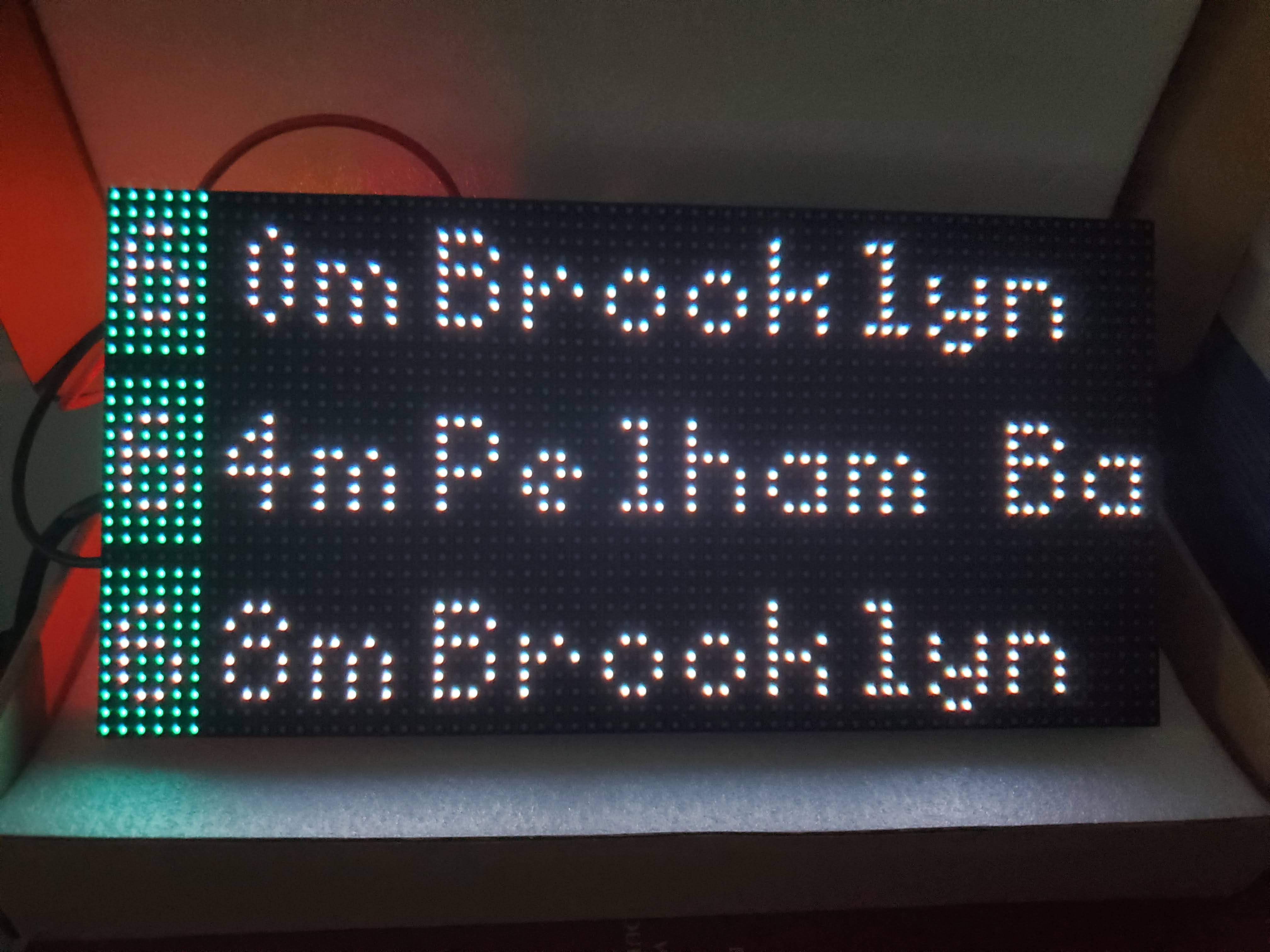DIY Subway LED Matrix
— 3 min read

GTFS
GTFS is the General Transit Feed Specification, originally developed by Google, which provides a way for users to retreive static data about any transit sytstem. The best way to get an understanding about GTFS is by looking at this example GTFS feed. It covers arll the major files that are included in the GTFS Specification. For this project we care most about the following files. Parsing gtfs data is pretty straightforward, since everything is in csv files, and everything has an ID, all we have to do is parse the CSV files, pick out the columns we want, and put all the data into datastructres that are more convenient than the columnar format provided. The parsing code can be found in NYCT._parse_static_data.
stops.txt
stops.txt provides details about all the stops and stations. For this project are most interested in lines with location_type == 1 (Stop or Platform) and location_type == 2 (Station). When parsing stops.txt we will map each Stop to it's parent station using the last column in stops.txt parent_station. This allows the user to specify which stations they want to monitor, and we can find the next upcoming train at that stop. Each line in this file will also provide a stop_id which we will use to match to arrival and departure times of trains.
routes.txt
routes.txt will provide us with the deails about each line in the system, this will give us the route_short_name, for example 6, and the route_color (green) and route_text_color (white). The route_id again will be used with the realtime data to provide which train is arriving at a given station.
GTFS and the MTA:
You can download the MTA's static GTFS data from here. Scroll all the way down to the bottom and click Yes, I agree to the these terms and conditions, which will them provide you to a link to Download the "New York City Transit Subway" GTFS data here. When you run the matrix script, this data will be automatically downloaded to /tmp for you.
In order to access the MTA's realtime data you will need to go to api.mta.info and sign up for an account so you can get an API Key. Once you get the API key you will need to save it in a file named .env, in the root directory of the cloned github repo with a single line:
MTA_API_KEY=XXXXXXXXXXXXXXXXXXXXXXXXAfter sigining in you will then need to download the GTFS Realtime Proto File and NYCT Subway Proto Extensions. If you have cloned the github repo, these files are already included and will be compiled when you run make in the root directory. This project does not use the NYCT extensions, but the are available if you like.
Finally, each collection of subway lines has its own realtime url which can be found on the Subway Realtime Feeds page. These are also already included here
Hardware:
- Parts List: https://github.com/riffnshred/nhl-led-scoreboard/wiki/Hardware
- Step by Step Guide: https://github.com/riffnshred/nhl-led-scoreboard/wiki/Step-by-step-guide.
I highly reccomend you read the guide above for all the details of how to set up the LED matrix, and the parts/skills required.
Software:
Installation:
get clone git@github.com:versi786/subway-led-matrix.gitcd ./subway-led-matrix./scripts/install.sh
echo MTA_API_KEY=XXXXXXXXXXXXXXXXXXXXXXXX >> .envList all stops available:
sudo python3 -m main \ --list-stopsThe easiest way to find the stops you care about is by using grep for example:
sudo python3 -m main \ --list-stops \ | grep -i 'grand central'Running the script, provide whatever stops you like from the output of the previous script:
sudo python3 -m main \ --led-rows=32 \ --led-cols=64 \ --led-gpio-mapping=adafruit-hat-pwm \ --led-brightness=20 \ --led-slowdown-gpio=4 \ --stop 'Grand Central-42 St' \ --stop 'World Trade Center'The script must be run as sudo to access the Raspberry Pi's GPIO functionality. For more details on the RGB Matrix check out the library's README here for how to change the matrix parameters here
References:
- Jeff Kessler's talk at Transportation Camp Philadelphia: video
- nolanbconaway/underground
- fsargent/BARTSign
- MLB-LED-Scoreboard/mlb-led-scoreboard
- riffnshred/nhl-led-scoreboard